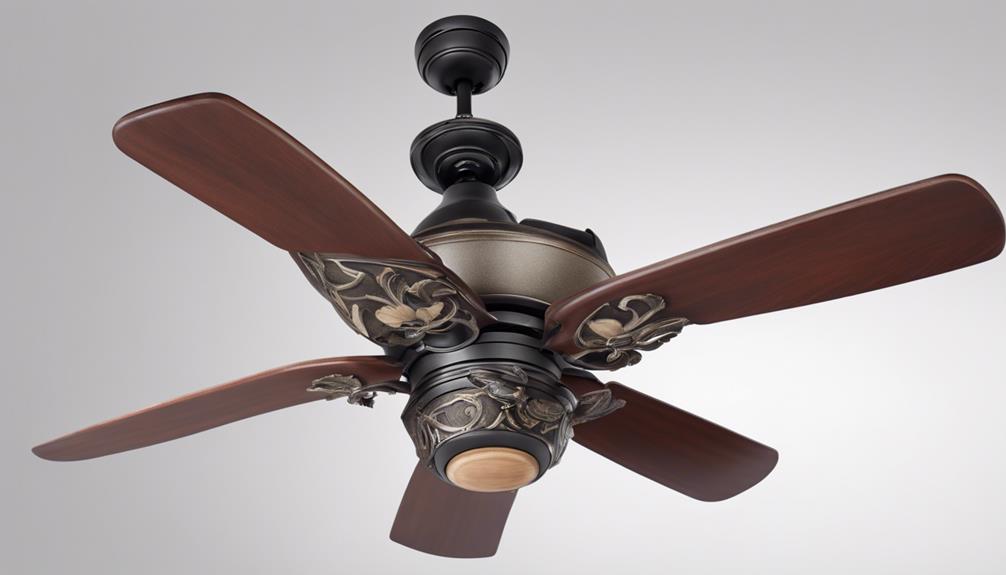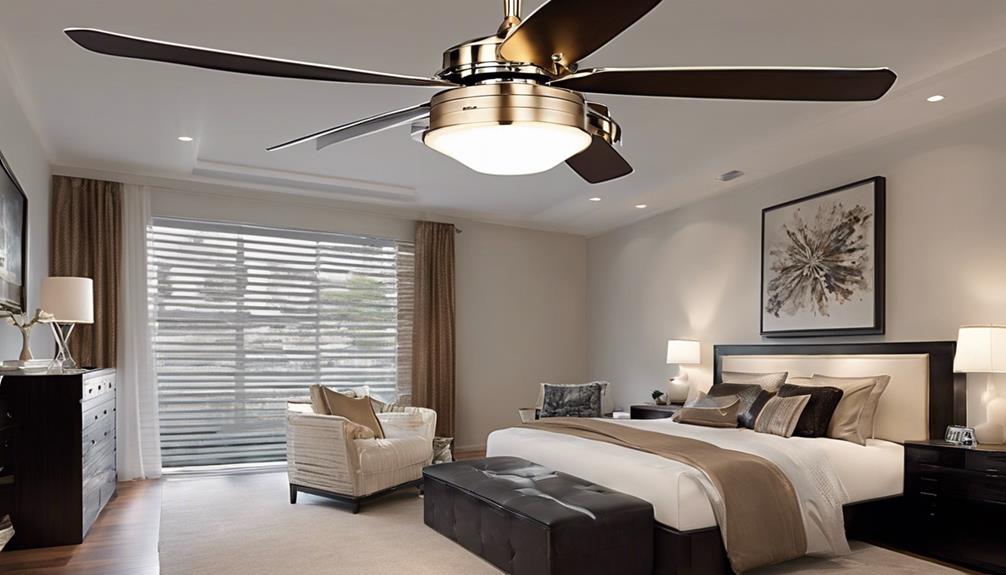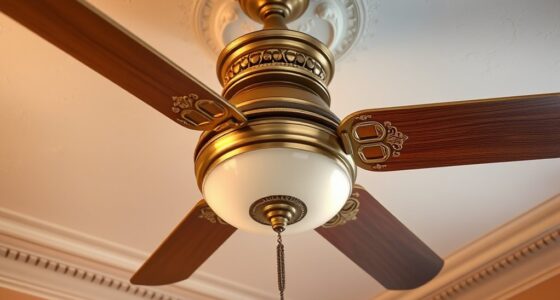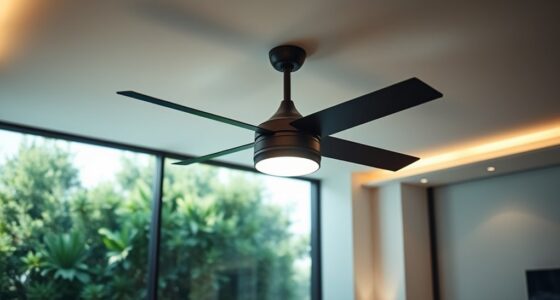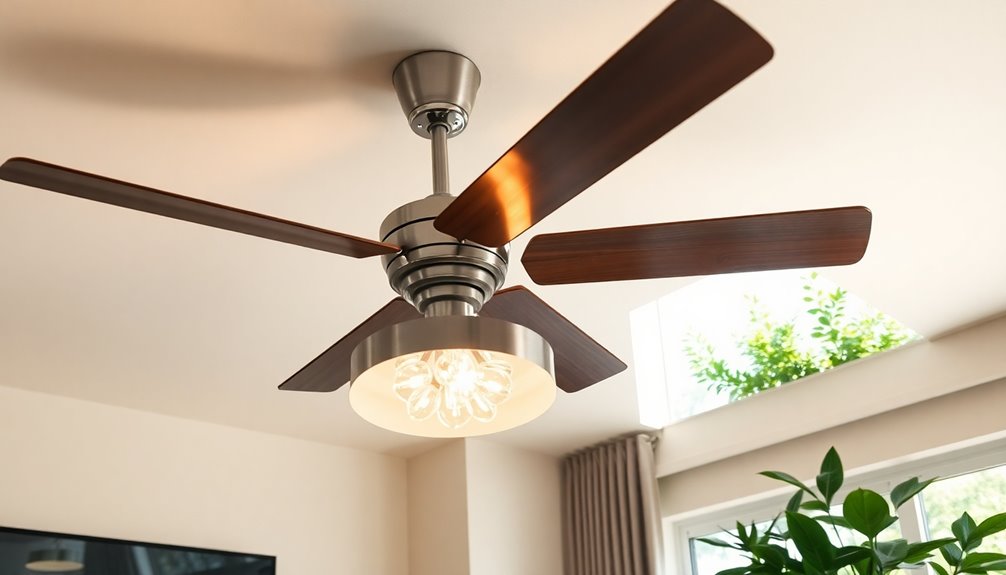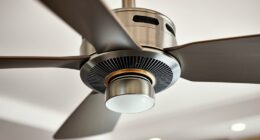When deciding on the number of blades for a ceiling fan, it's essential to consider the balance between performance and noise levels. Fewer blades can mean faster air movement, leading to a stronger breeze for quicker cooling, while more blades often result in quieter operation due to better balance. Both industrial and residential fans typically find efficiency with two or three blades, but the optimal number depends on factors like room size and aesthetics. Remember, the right blade count can impact airflow efficiency, noise levels, and cooling effectiveness, so choose wisely!
Key Takeaways
- Optimal blade count for efficiency is generally three for residential ceiling fans.
- Fewer blades create faster air movement, providing a stronger breeze for quicker cooling.
- Balance between blade count and performance is crucial for air circulation efficiency.
- Consider desired noise level when choosing between different blade counts.
- Industrial fans typically feature 2 or 3 blades for efficient airflow.
Impact of Blade Count on Performance
Having fewer blades on a ceiling fan enhances its performance by allowing for faster air movement and a stronger wind chill effect. When it comes to the blade count of a ceiling fan, it significantly impacts how well the fan operates.
A fan with fewer blades tends to move air more quickly, creating a refreshing breeze that can make a room feel cooler. This faster movement of air also results in a more pronounced wind chill effect, making you feel cooler without adjusting the thermostat.
On the other hand, ceiling fans with more blades provide a gentler airflow, which mightn't be as effective in cooling you down quickly. Therefore, if you're looking for a ceiling fan that can efficiently cool a room and create a strong breeze, opting for one with fewer blades could be the way to go.
Noise Level Considerations

When selecting a ceiling fan, considering the noise level is crucial for creating a peaceful environment in your room. Different factors affect the noise level of a ceiling fan, with blade count being a significant consideration. Here are some key points to keep in mind:
- Fans with more blades are generally quieter due to better balance and reduced ambient noise.
- Increased blade count contributes to lower noise levels during fan operation.
- More blades can help in achieving a quieter environment in the room.
- Consider the desired noise level when choosing between fans with different blade counts.
Industrial Fan Blade Count
Industrial fans typically feature 2 or 3 blades to optimize air movement efficiency. The blade count on industrial fans is carefully chosen to ensure powerful airflow and cooling performance in large spaces. By having either 2 or 3 blades, industrial fans can reduce drag on the motor, leading to better energy efficiency.
These fan blades are specifically engineered to provide strong air circulation, making them ideal for industrial settings where robust airflow is necessary. The balance between blade count and performance is crucial in industrial fan design, as it impacts both the effectiveness of air movement and the energy consumption of the fan.
Whether it's a warehouse, factory, or other industrial space, having 2 or 3 blades on the fan helps to achieve the desired level of airflow efficiency without compromising on power.
Residential Fan Blade Count

When choosing a ceiling fan for a residential space, it's important to consider the optimal number of blades, efficiency, and performance, as well as aesthetics and design.
The number of blades can impact how well the fan circulates air in your home, so it's essential to find a balance that suits your preferences.
Whether you opt for three blades for cost-effectiveness, five blades for quieter operation, or four blades for a blend of style and efficiency, your choice will impact both the look and function of your fan.
Optimal Blade Number
In residential settings, the optimal blade count for a ceiling fan is often recommended to be three blades for maximum efficiency. When considering the blade count of a ceiling fan, it's essential to keep in mind the impact on efficiency and performance.
Here are some key points to consider:
- Three blades are commonly recommended for optimal efficiency.
- Additional blades may reduce efficiency in residential ceiling fans.
- More blades can increase drag on the motor, affecting performance.
- Quality motor construction is crucial for quieter operation in residential settings.
Choosing the right blade count is crucial to ensure your ceiling fan operates efficiently and effectively, providing comfort and style to your living space.
Efficiency and Performance
Choosing the optimal number of blades is crucial for maximizing efficiency and performance in residential ceiling fans. For residential ceiling fans, three blades are often considered the best option. Having additional blades can lead to decreased efficiency due to increased drag on the motor.
It's essential to prioritize a high-quality motor as it tends to be quieter and less intrusive, contributing to better overall performance. Factors like room size and installation location also significantly impact the effectiveness of a ceiling fan.
Aesthetics and Design
Opting for a 4 or 5-blade design in residential ceiling fans often reflects a preference for both aesthetic appeal and balanced air circulation. When choosing a fan, aesthetics and personal style are key factors to consider.
Here are some points to keep in mind:
- Blade fans with wood blades can enhance the warmth and coziness of a room.
- The number of blades can impact the visual symmetry of the fan, complementing various décor styles.
- Hunter Fan Company offers a range of 5-blade fans, blending style and functionality seamlessly.
- Ultimately, the decision between 4 or 5 blades in residential fans depends on individual taste and the overall design scheme of the room.
Personal Preference and Aesthetics

Considering personal style and room decor is crucial in determining the ideal number of blades for a ceiling fan. Personal taste plays a significant role in whether you prefer the symmetrical look of a 4 or 5 blade fan or the modern simplicity of a 3 blade fan. It's essential to match the blade count to the overall aesthetic of the room to create a cohesive and visually appealing space.
| Ceiling Fan Blades | Personal Taste | Room Decor |
|---|---|---|
| 3 Blades | Modern | Minimalist Design |
| 4 Blades | Symmetrical | Classic Style |
| 5 Blades | Traditional | Ornate Settings |
When choosing the number of blades for your ceiling fan, it's essential to consider what aligns best with your personal preferences and the existing decor of the room. This way, you can ensure that the ceiling fan not only functions effectively but also enhances the overall look and feel of the space, providing a sense of belonging and harmony.
Blade Count and Air Circulation

The number of blades on a ceiling fan greatly impacts how efficiently it circulates air. More blades can sometimes lead to reduced airflow efficiency due to increased drag on the motor.
Achieving optimal air circulation involves finding the right balance between blade count, motor power, and blade pitch.
Blade Number Efficiency
Having the right number of blades on a ceiling fan significantly impacts its efficiency in circulating air within a room. When considering blade number efficiency, keep in mind:
- Fewer blades result in less drag on the motor, enabling faster and more efficient air movement.
- Fans with fewer blades create a stronger wind chill effect due to increased airflow and quicker rotation.
- More blades offer a softer breeze and quieter operation, catering to diverse cooling needs.
- Blade count affects air circulation efficiency, noise levels, and overall cooling effectiveness, providing various options to suit individual preferences.
Airflow Impact Study
Blade count significantly influences the airflow efficiency of a ceiling fan, with fewer blades typically resulting in faster air circulation. While the number of blades is essential, factors like blade pitch and motor power also play crucial roles in optimizing air circulation.
Industrial fans with fewer blades achieve powerful airflow, while residential fans commonly feature 4 or 5 blades for balanced circulation. Blade pitch, measured in degrees, is vital for enhancing a fan's performance and airflow efficiency.
Advancements in fan design and motor technology have diminished the sole reliance on blade count for determining airflow effectiveness. By considering blade count alongside blade pitch and motor power, one can ensure efficient air circulation in both industrial and residential settings.
Blade Count and Noise Reduction

To achieve quieter fan operation, opting for a higher blade count can significantly reduce noise levels. Fans with more blades create better balance, leading to a reduction in ambient noise.
Here are some key points to consider:
- Increased blade count contributes to improved balance, resulting in quieter fan operation.
- More blades help in achieving natural balance within the fan, which in turn leads to reduced noise levels.
- Blade count directly impacts the noise level of the fan during operation.
- It's essential to note that while blade count plays a role in noise reduction, the quality of the motor construction is also crucial for ensuring a quiet fan experience.
Choosing a ceiling fan with a higher blade count can help create a more peaceful environment by minimizing unwanted noise. By considering both blade count and motor quality, you can enjoy a quieter fan that enhances your living space.
Blade Count and Motor Drag

When considering the relationship between blade count and motor drag in ceiling fans, one must acknowledge the impact on airflow efficiency and air movement intensity. The number of blades on a ceiling fan plays a crucial role in determining its energy efficiency. Fans with fewer blades experience less drag on the motor, allowing for faster and more efficient air circulation. This increased efficiency results in a stronger wind chill effect, making the room feel cooler. Additionally, fans with fewer blades tend to be more dynamic, generating a powerful airflow that can be customized based on individual preferences.
In contrast, ceiling fans with more blades may have a smoother operation and are often quieter due to better balance. This makes them suitable for spaces where noise levels need to be minimized. However, fans with more blades may not be as energy efficient as those with fewer blades. Therefore, when looking to maximize energy efficiency and airflow intensity, opting for a ceiling fan with a lower number of blades can be a beneficial choice.
Factors Influencing Blade Choice

When selecting ceiling fan blades, it's essential to consider factors like blade material options and blade size.
The material of the blades can affect their durability and appearance, while the size impacts the fan's overall performance.
Blade Material Options
Wood, metal, plastic, and composite materials offer diverse options for ceiling fan blades to cater to various aesthetic preferences and decor styles. Each material brings unique features to consider when selecting the right fan for your space:
- Wood Blades: Provide a traditional and elegant look, ideal for classic or rustic decor styles.
- Metal Blades: Known for durability, easy maintenance, and commonly used in modern or industrial-themed spaces.
- Plastic Blades: Budget-friendly, lightweight, and available in a range of colors and finishes.
- Composite Blades: Combine materials for enhanced durability, moisture resistance, and versatile style options.
Exploring these blade material options can help you find the perfect ceiling fan to complement your room's ambiance and design.
Blade Size Consideration
Considering the impact of blade size on a ceiling fan's performance and efficiency is crucial when selecting the right fan for a room. Blade size directly influences the airflow intensity produced by the fan. Larger blades typically move more air, which can enhance cooling but might also lead to increased noise levels.
On the other hand, smaller blades are often quieter but may not circulate air as effectively. When deciding on blade size, factors such as room size, ceiling height, and desired airflow intensity should be taken into account. It's important to find a balance between blade size and performance to ensure optimal cooling capabilities while maintaining efficiency and comfort in the room.
Motor Strength and Blade Performance

The efficiency and performance of a ceiling fan heavily rely on the strength of its motor and the design of its blades. When considering motor strength and blade performance, it's essential to understand the following:
- Motor Strength: A powerful motor is crucial for optimal airflow and efficiency of the fan.
- Blade Design: The design and material of the blades significantly impact the circulation produced by the fan.
- Airflow: Hunter offers WhisperWind and DC motors known for their high-velocity airflow capabilities, ensuring effective cooling.
- Efficiency: Blade pitch, along with motor strength, plays a critical role in maximizing the fan's efficiency, making it cost-effective and energy-efficient.
Considering these factors when selecting a ceiling fan can help you choose one that not only complements your space aesthetically but also provides excellent performance and comfort.
Blade Shape and Material Impact

Blade shape and material play a significant role in enhancing the efficiency and performance of a ceiling fan by influencing how effectively air circulates in the room. The design of the blades is crucial for optimal airflow, ensuring that the fan effectively cools the space.
High-quality blade materials not only guarantee durability but also contribute to better airflow within the room. Different blade shapes can impact not only the efficiency and performance of the fan but also the noise level it produces and its energy efficiency.
It's essential to choose a blade shape that maximizes the fan's cooling capabilities while also considering the material used to manufacture the blades. By selecting the right blade shape and material, you can improve the overall performance of your ceiling fan, creating a more comfortable environment in your living space.
Blade Pitch Effects

Influencing the efficiency of air circulation in a ceiling fan, the blade pitch, measured in degrees, plays a crucial role. The optimal blade pitch for small fans is around 12 degrees, while standard-sized fans benefit from a pitch between 13 and 15 degrees to maximize air movement.
Here are some effects of blade pitch on a ceiling fan:
- Blade pitch determines the efficiency of air circulation, affecting how effectively the fan moves air in a room.
- An ideal blade pitch is crucial for achieving optimal performance, ensuring that the fan operates at its best capacity.
- Adjusting the blade pitch can enhance the fan's efficiency, especially if the initial pitch isn't suitable for the room size or fan type.
- Correct blade pitch contributes significantly to the overall effectiveness of the ceiling fan in maintaining proper air circulation.
Understanding and optimizing the blade pitch of a ceiling fan is essential for achieving the best performance and air circulation in your living space.
Choosing the Right Blade Number

Optimizing the number of blades on a ceiling fan plays a significant role in both its performance and aesthetics. When considering blade ceiling fans, the choice between 3, 4, or 5 blades is crucial in achieving the desired balance of energy efficiency and ambient noise levels.
Fewer blades on a ceiling fan result in less drag on the motor, promoting faster and more efficient air circulation, ideal for those seeking a stronger airflow intensity. In contrast, more blades can lead to quieter operation due to enhanced balance, reducing ambient noise for a peaceful environment.
The decision ultimately depends on personal preferences like desired energy consumption, noise tolerance, and room size. Whether aiming for a brisk breeze or a serene atmosphere, selecting the right blade number for your ceiling fan ensures optimal performance tailored to your needs.
Frequently Asked Questions
Is a 3 or 5 Blade Ceiling Fan Better?
I believe a 5-blade ceiling fan might be better for those seeking quieter operation and a different aesthetic. It could enhance air circulation and reduce noise levels.
However, a 3-blade fan could offer cost savings, dynamic balance, and potentially higher speeds with lower energy consumption.
Ultimately, the choice between the two depends on individual preferences for noise levels, aesthetics, and cooling efficiency.
Does the Number of Blades on a Ceiling Fan Matter?
I believe the number of blades on a ceiling fan matters when considering factors like blade design, air circulation, energy efficiency, and noise level. Different blade counts can impact how efficiently the fan moves air and how quietly it operates.
Modern technology has allowed for various blade configurations to provide effective cooling and circulation. Ultimately, the right number of blades depends on personal preference and the specific needs of the space.
Which Is Better a 3 or 4 Blade Ceiling Fan?
When it comes to choosing between a 3 or 4 blade ceiling fan, it boils down to personal preference and room requirements.
3-blade fans offer dynamic blade balance for high speeds and consume less energy. On the other hand, 4-blade fans tend to be quieter and can enhance room aesthetics.
Consider the balance between energy efficiency and noise levels to make the best choice for your space.
What Is the Most Efficient Number of Blades on a Ceiling Fan?
I find that the most efficient number of blades on a ceiling fan is typically three.
Having fewer blades can enhance energy consumption and air circulation.
Opting for a lighter blade design can also help in reducing noise levels.
It's important to consider these factors along with room size and installation location for optimal performance.
Ultimately, a three-blade ceiling fan strikes a good balance between efficiency and functionality in most residential settings.
Are Retractable Blade Ceiling Fans More Effective Than Traditional Fans with Fixed Blades?
When it comes to cooling your space, top 10 retractable blade fans are more effective than traditional fans with fixed blades. The ability to retract the blades when not in use allows for better air circulation, making them more efficient at keeping your room cool and comfortable.
Conclusion
In conclusion, when it comes to choosing the right number of blades for your ceiling fan, remember that more isn't always better. Each blade count has its own advantages and drawbacks, so it ultimately comes down to personal preference and the specific needs of your space.
Don't be swayed by trends or myths – trust your instincts and go with what works best for you. After all, it's your home and your comfort that matters most.
